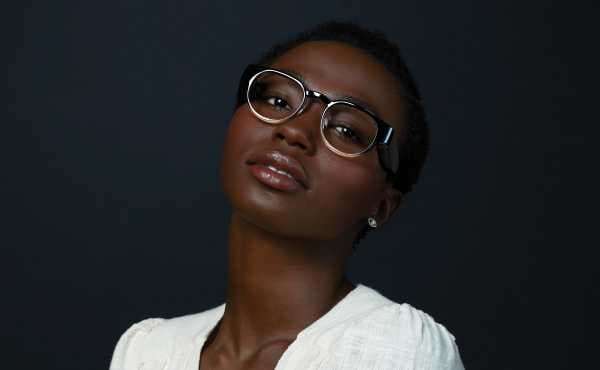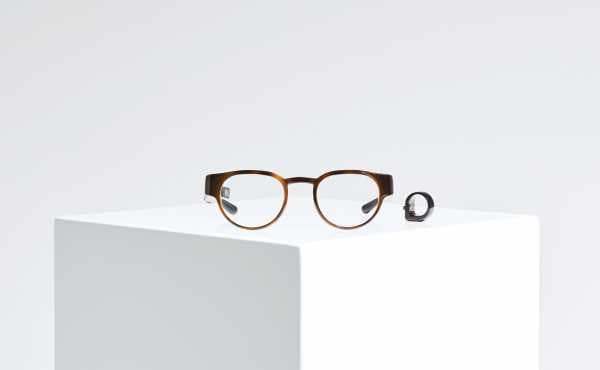

Would you look at your phone less if your notifications were available without it, hovering in the air just a few feet away from your face? Would you buy a pair of glasses, even if you don’t actually need glasses for medical reasons, to achieve this state of always-on but possibly slightly less demanding engagement with your digital life?
Focals, the augmented reality glasses released Monday by the startup Thalmic Labs — now going by “North,” because it sounds more like a “fashion and lifestyle” brand and less like a tech company — are a response to these odd hypothetical questions.
There’s no screen in Focals, just light filtering through, according to founder Stephen Lake, “a holographic lens that never existed before.” The holographic display appears at arm’s length, a friendly and colorful interruption. It’s off by default, and wakes up only when it has something urgent to tell you, or if you ask it to.
You can click through suggested auto-response text messages, into more detailed summaries of the weather, or through your calendar to see where your next appointment is even while you’re in your current one. You do so using the paired black or copper ring (called the Loop) on your index finger, which is equipped with a little joystick.

What Focals can do is limited, intentionally. The glasses have a custom version of Amazon’s Alexa voice assistant that you have to wake for it to talk or listen. They can show you text messages (or Slack notifications, if you fiddle with the settings), turn-by-turn navigation, reminders from your calendar, and the weather. If you want to talk to Alexa, it can call you an Uber, browse headlines, or control your smart home devices.
North’s go-to line is that the company is “committed to building a future where technology is there when you need it and gone when you don’t, hidden by design.”
“Digital presence is just as important as physical presence,” North designer Marie Stipancik says. “But we want people to live with their heads up.” Her job was making the glasses look like something a “professional with a busy personal life” would want to wear all day.
“Digital presence is just as important as physical presence, but we want people to live with their heads up”
There are only two places in the world where you can buy Focals. The first is in Toronto; the second is in Cobble Hill, the neighborhood of Brooklyn currently best known for its Trader Joe’s and its rich people (including Daniel Craig). Secretly, North has been outfitting a storefront at 178 Court Street over the past several months. The company is designing a high-end eyewear shop in which it hopes to show you the future, with the help of $136 million in venture funding, shelled out in large part by Intel Capital and Amazon. Retail rents in the vicinity are about $134 per square foot.
Focals go for $999 each, and come in tortoise-shell, grey, or black, in a “classic” or round style. They’re custom-made for your face, and you must go into one of the two North-owned stores for a scan of your skull before they can be built.
The glasses look good from the front and awkwardly bulky from the side, mostly on the wearer’s right side, where there is a tiny projector positioned on their temple. (According to Lake: “The most precise projector ever built. We had to invent that.”)
If you want a pair of Focals, you can preorder them online, but you also have to schedule an appointment and have 11 cameras take pictures of your head and build models of your face. It’s “a white glove experience,” Lake says. It turns the purchase into a kind of freaky sci-fi ceremony, in which you sign some release forms to get an ultra-customized product that’s meant to be part of your life all day, every day.

Focals’ obvious comparisons are the ambitious Google Glass experiment, which failed because its usefulness wasn’t well-explained to a doubting public, and the fun but ultimately doomed investment of Snap Spectacles, which lost Snapchat’s parent company $40 million when novelty wasn’t enough to make them catch on.
Lake is polite but frank in arguing why these ventures don’t fit in the same sentence as his product. “We’re not Google, we’re not a tech company that’s trying to take [the technology] we already have and shove it on your face,” he says. North built all the ingredients for Focals from scratch, he notes; 500 people have been working on it for five years.
Recently, I went to Cobble Hill and tried some Focals. The demo glasses routed me to Carrie Bradshaw’s New York apartment, and told me it would be cold in Brooklyn all day. They did so with glimmering little cartoons! The images were close enough to me to make me feel like they were my cartoons alone, but not so close that I felt like I’d been turned into a robot.
Though I have never tested Intel’s Vaunt AR glasses — which use retinal projection to display images on the inside of your literal eyeball — I think I can safely say I’m more comfortable with this arrangement. Though I have never tested Vuzix’s Blade AR glasses — which put a full screen in the upper-right corner of your field of vision — I think I would hate them. Though Focals are admittedly clunky when viewed from the side, I really only encourage people to look directly at the front of my face anyway.
Focals are clunky when viewed from the side, but I really only encourage people to look directly at the front of my face anyway
And what if I were to never accidentally spend 20 minutes in a bar bathroom, watching Instagram Stories on the toilet, ever again? What if I could always check, without leaving the room or stopping my conversation, to see if my rude boyfriend is on his way? That would be amazing! I would be so much more pleasant to hang out with.
During the test, my display blinked in and out, seemingly mostly because the non-custom pair was too big for me. It was obvious that it would take time to get used to the display, which only pops up when you’re looking forward, and disappears if you look away.
But from what I could tell, it genuinely was non-invasive and convenient — a good way to navigate long walks through unfamiliar neighborhoods without staring at Google Maps and walking into a tree, a good way to avoid rummaging in your pocket while carrying a bag of groceries. Wearing glasses already makes you a cyborg, technically; I can admit that adding AR might not be so big of an adjustment.
Focals mostly offer a good way not to take out your more powerful device with the goal of performing a simple task, and end up lured into any one of its dozens of seductive time-sucks. I spent only about half an hour in the freezing, unfinished Focals store, and have no intention of ever spending $1,000 on the device. But I have to concede I found the glasses, as a hint of what the future of personal gadgets might look like, oddly comforting.
Sourse: vox.com






